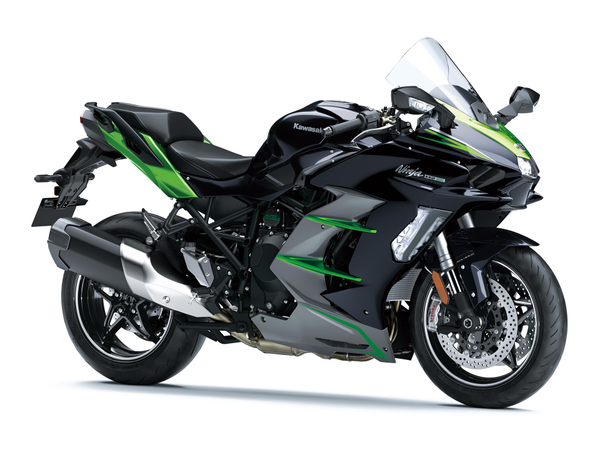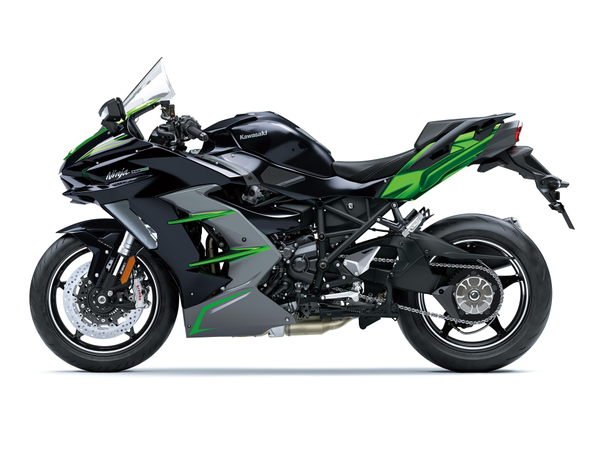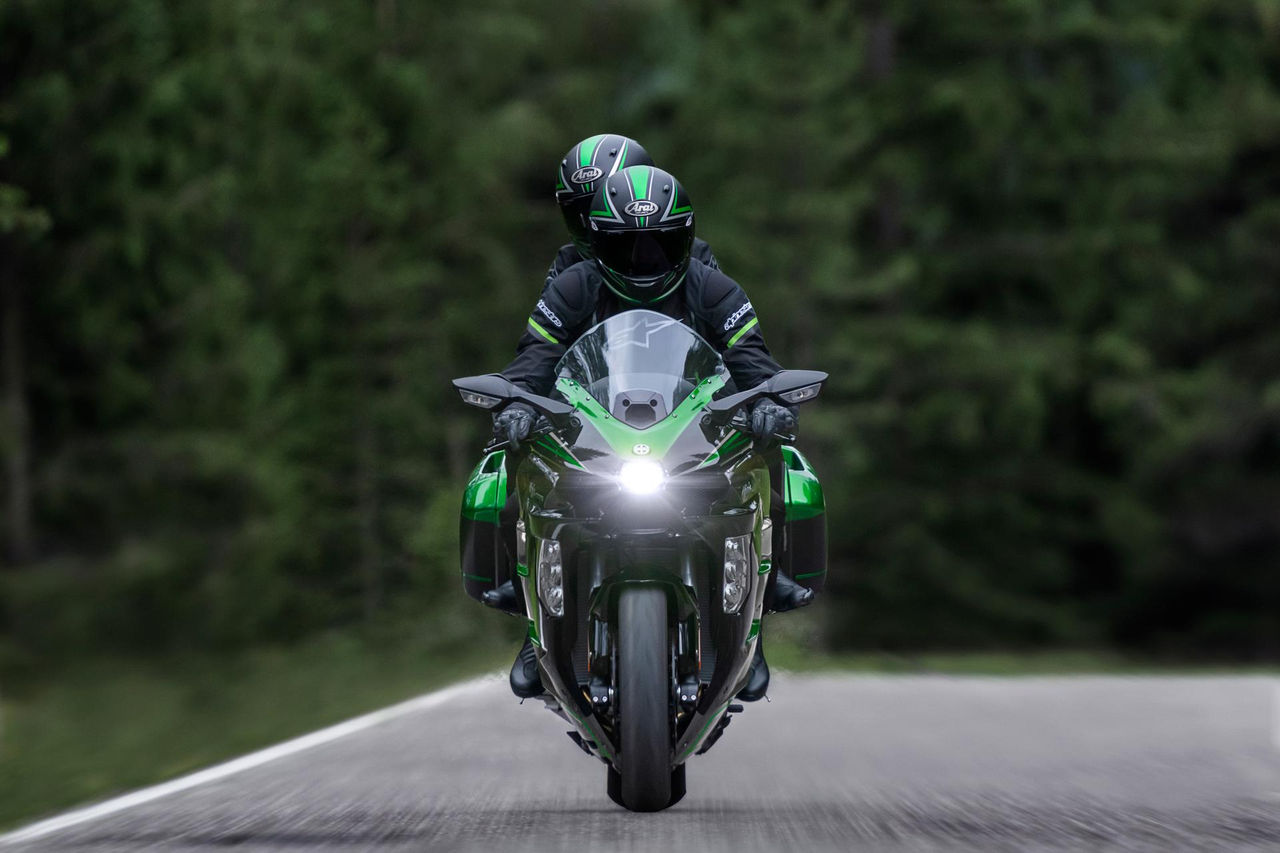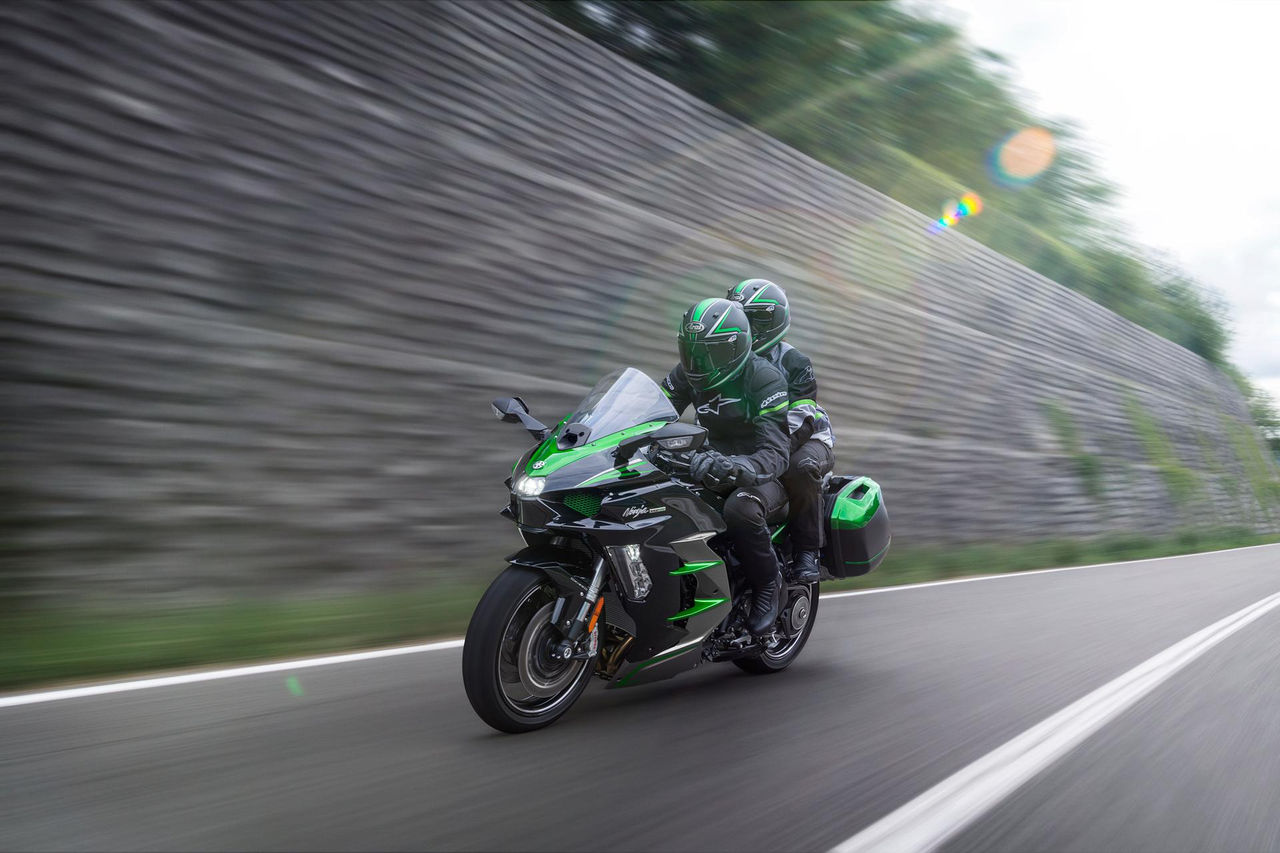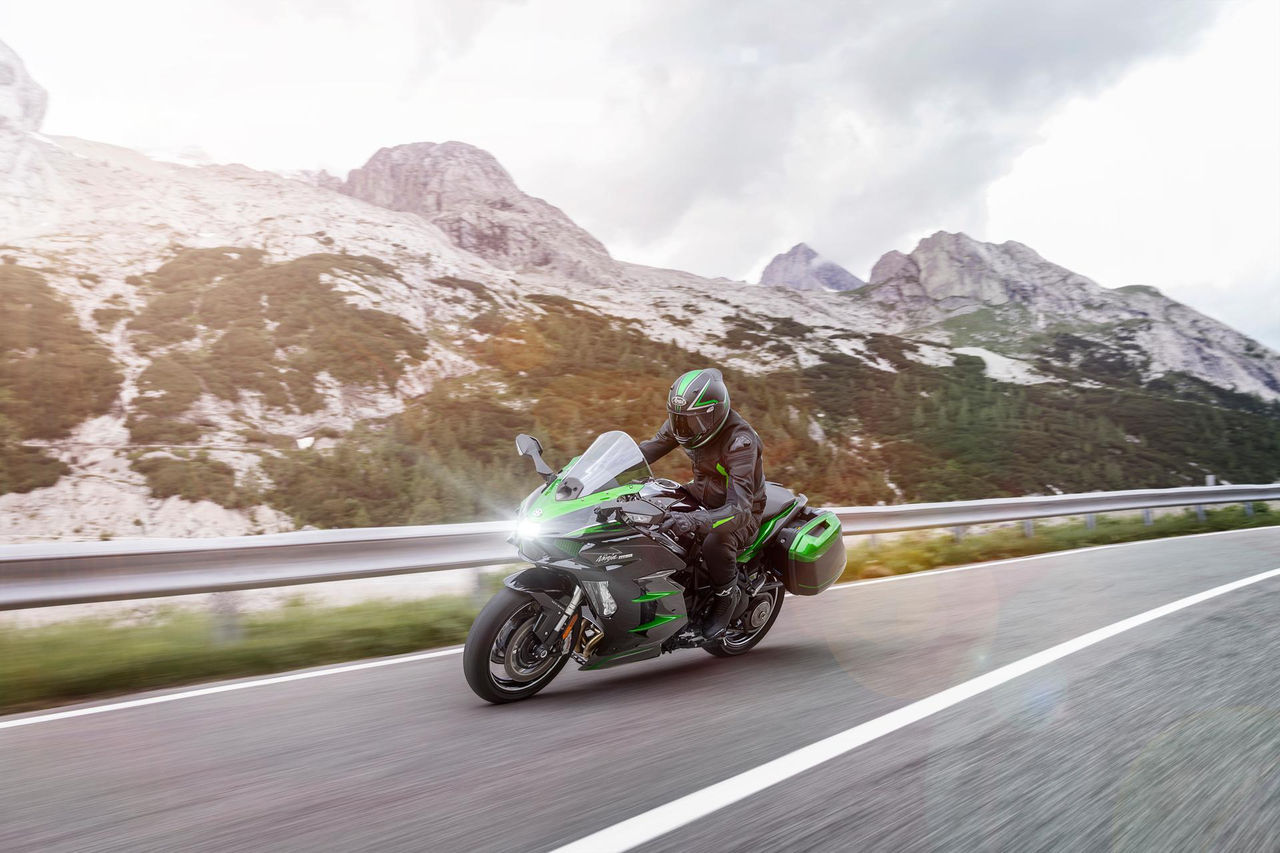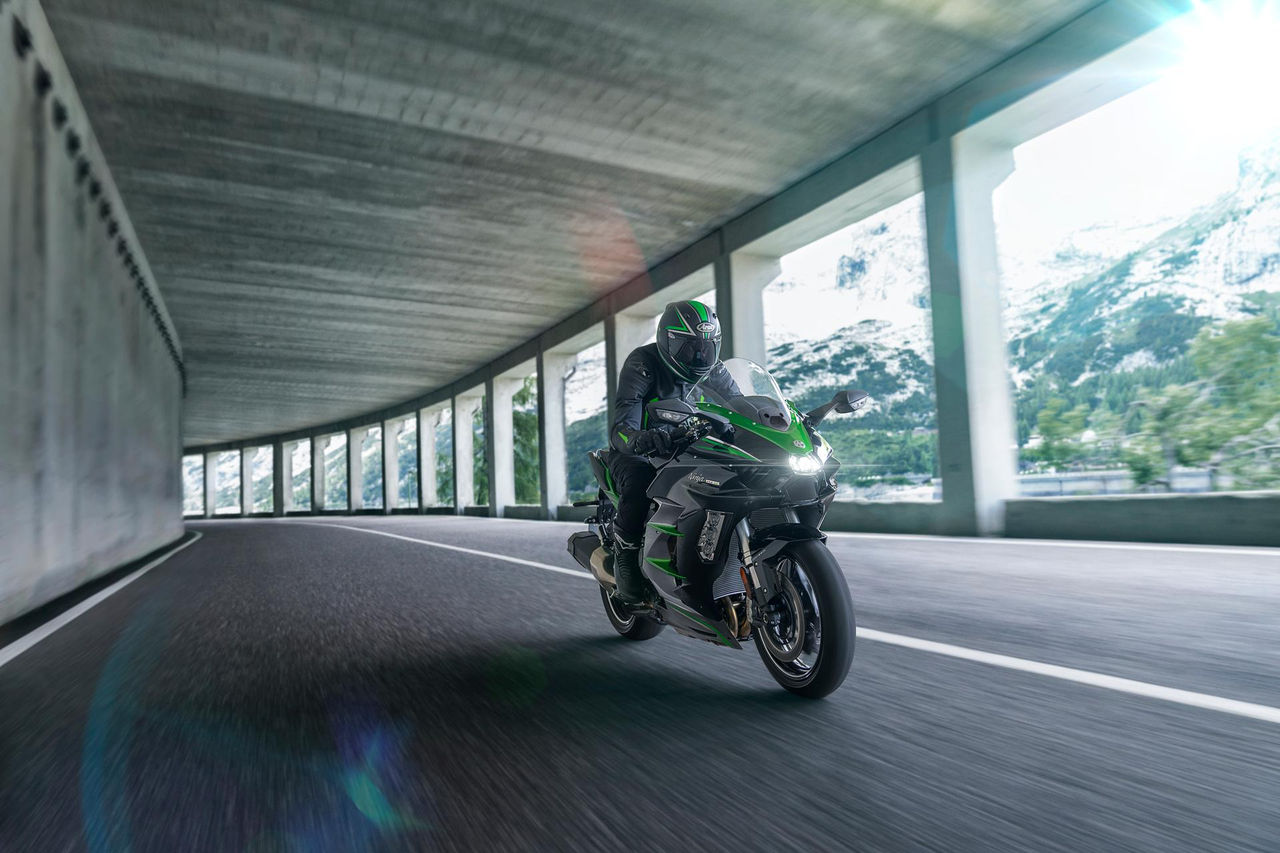Ninja H2 SX SE
New 2024.
Ninja H2 SX SE
The Kawasaki Ninja H2 SX is Kawasaki’s most advanced Sports Tourer ever; the ultimate integration of the highest standards of technology, performance and riding comfort. New dedicated features like the ARAS system provide real world benefits including adaptive cruise control and blind spot detection. Integrated into the new 6.5” colour TFT instrumentation is Kawasaki’s SPIN Infotainment system. Experience the exhilaration of the unique balanced supercharged engine for both long distance touring and daily riding. The best technology is that which becomes a natural extension of ourselves and sets us free. Ninja H2 SX. ENGINEERED TO BE FREE.
| Boja | Emerald Blazed Green / Metallic Diablo Black / Metallic Graphite Gray |
|---|
Ninja H2 SX SE
Ninja H2 SX SE Specifications
Engine
| Engine type | Liquid-cooled, 4-stroke, in-line four with Supercharger |
|---|---|
| Compression ratio | 11.2:1 |
| Valve system | DOHC, 16 valves |
| Bore x stroke | 76.0 x 55.0 mm |
| Displacement | 998 cm³ |
| Fuel system | Fuel injection with dual injection: 40 mm x 4 |
| Lubrication | Petrol mix |
| Starting system | Electric |
| Ignition system | Digital |
Performance & Transmission
| Maximum power | 147.1 kW {200 PS} / 11,000 rpm |
|---|---|
| Maximum power with RAM Air | 154.1 kW {210 PS} / 11,000 rpm |
| Maximum torque | 137.3 N•m {14.0 kgf•m} / 8,500 rpm |
| CO2 emission | 128 g/km |
| Fuel consumption | 5.4 l/100km |
| Transmission | 6-speed, return shift |
| Clutch | Wet, multi disc |
| Primary reduction ratio | 1.480 (74/50) |
| Gear ratios 1st | 3.077 (40/13) |
| Gear ratios 2nd | 2.429 (34/14) |
| Gear ratios 3rd | 2.045 (45/22) |
| Gear ratios 4th | 1.727 (38/22) |
| Gear ratios 5th | 1.524 (32/21) |
| Gear ratios 6th | 1.348 (31/23) |
| Final drive | Sealed chain |
| Final reduction ratio | 2.444 (44/18) |
Frame & Dimensions
| Frame type | Trellis, high-tensile steel with swingarm mounting plate |
|---|---|
| Trail | 103 mm |
| Wheel travel front | 120 mm |
| Wheel travel rear | 139 mm |
| Tyre, front | 120/70 ZR17 M/C (58W) |
| Tyre, rear | 190/55 ZR17 M/C (75W) |
| L x W x H | 2,175 x 790 x 1,260 mm |
| Steering angle L R | 30° / 30° |
| Wheel base | 1,480 mm |
| Ground clearance | 130 mm |
| Fuel capacity | 19.0 litres |
| Seat height | 835 mm |
| Curb mass | 267 kg |
Brakes & Suspension
| Front brake type | Dual semi-floating discs |
|---|---|
| Front brake diameter | Ø 320 mm |
| Front brake caliper type | Brembo radial-mount, Stylema monobloc, opposed 4-piston |
| Rear brake type | Single disc |
| Rear brake diameter | Ø 250 mm |
| Rear brake caliper type | Dual-piston |
| Front suspension type | Inverted fork with KECS-controlled compression and rebound damping, manual spring preload adjustability, and top-out springs |
| Front suspension diameter | Ø 43 mm |
| Rear suspension type | Uni-Trak, BFRC lite gas-charged shock with piggyback reservoir, KECS-controlled compression and rebound damping, and remote spring preload adjustability |
Ninja H2 SX SE Features
Originally conceived to be the fastest sport tourer on the Autobahn, the Ninja H2 SX offers a unique riding experience. With supercharged acceleration and the equipment to cover long distances in comfort, Kawasaki’s supercharged sport tourer will have riders smiling in their helmets as they eat up the miles.
The Ninja H2 SX is Kawasaki’s first model to integrate an FI-ECU with torque-demand capabilities; new IMU that measures in six DOF; and boost-circuit-equipped ABS with high computational power, enabling coordinated chassis control. Equipped with Bosch’s Advanced Rider Assistance Systems and (on the SE model) Showa’s Skyhook Technology, the Ninja H2 SX is Kawasaki’s most advanced model to date.
Befitting a flagship model, the Ninja H2 SX features large, full colour instrumentation in addition to a host of high-grade convenience features including KIPASS and TPMS.
Designed to offer both power and fuel efficiency, the Balanced Supercharged Engine delivers a maximum power of 200 PS. Tuning focused on the low-mid range prioritises everyday usability in street-riding situations over outright performance, and helps to achieve fuel efficiency exceeding that of the Ninja 1000SX and Versys 1000.
KECS, Kawasaki’s semi-active electronic suspension system, adapts to road and riding conditions in real time, providing the ideal amount of damping called for. Updated software incorporates Skyhook technology to deliver an even more composed ride, contributing to increased comfort and enjoyment.
Kawasaki’s highly sophisticated electronic management systems offer rider support to allow them to more fully experience how the Ninja H2 SX is fun and rewarding to control.
Bosch’s radar-based ARAS systems made their Japanese mass-production motorcycle debut on the Ninja H2 SX. These surround sensing technology features help add to rider reassurance while touring or riding in heavy traffic.
On the SE model, high-spec Brembo Stylema monobloc calipers offer enhanced control. The compact, lightweight calipers minimise the internal space taken up by fluid, enabling a more direct response. Stylema calipers cool very rapidly thanks to a design that promotes airflow around the brake pads, space around the pistons, and an opening that allows air to exit from the central bridge.
Activated when the rider has stopped and firmly applies the brake(s), VHA engages the rear brake to allow the rider to relax their brake hand/foot.
Kawasaki’s new smartphone-based infotainment app enables various third-party applications to be downloaded and displayed on the cockpit’s TFT display.
The rear-facing radar sensor monitors the bike’s surroundings and alerts the rider to presence of a vehicle approaching in the rider’s blind spot.
A more advanced version of Electronic Cruise Control, ACC maintains the speed set by the rider, but adjusts the vehicle speed to maintain a suitable following distance from the vehicle in front.
When the system determines that continuing at the current speed may result in a collision with the vehicle in front, it warns the rider.
TPMS continuously monitors tyre air pressure while riding, adding to rider reassurance on long tours.
Using a camera sensor to assess the brightness of the lights of vehicles ahead, of streetlights, etc. AHB automatically turns the bike’s high beams on or off as necessary. For the system to function, the dimmer/passing switch must be set to high beam, the bike must be travelling above 20 km/h, and it must be dark. When the system has been engaged, the icon displayed on the instrument screen will show green.
Lean-activated lights built into the fairings help illuminate the road when cornering.
Large, easy-to-read 6.5” full-colour TFT instrumentation adds a high-tech touch to the cockpit. Complementing the multiple display modes and smartphone connectivity, compatibility with Kawasaki SPIN offers numerous infotainment possibilities.
Ergonomically designed front seat both provides comfort for spending long hours in the saddle, and accommodates position changes for sportier riding. Both rider and passenger seats are wider than previous, and revised shapes, thickness and density add to rider and passenger comfort.
With its large windshield and full-fairing bodywork, the Ninja H2 SX provides substantial wind protection, contributing to rider comfort on long rides. In addition to contributing to sporty styling, the aerodynamically shaped bodywork is also a benefit when riding at highway speeds.
KIPASS (Kawasaki’s Intelligent Proximity Activation Start System) master key system allows remote activation of the bike’s main switch and steering lock.
During hard braking, ESS causes the brake light to flash, calling attention to the bike’s quick deceleration.
Attaching and removing the accessory panniers is simple and convenient thanks to the mounting system. When mounted, the panniers integrate seamlessly with the rear of the bike; when removed, the clutter-free design ensures the rear of the bike looks good.

